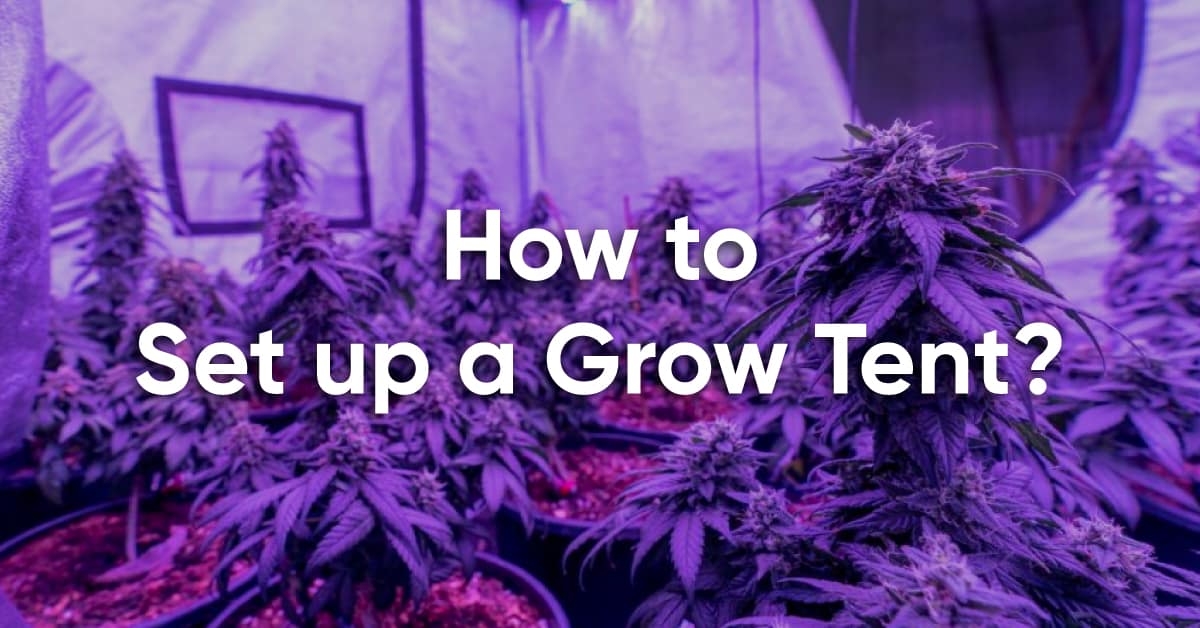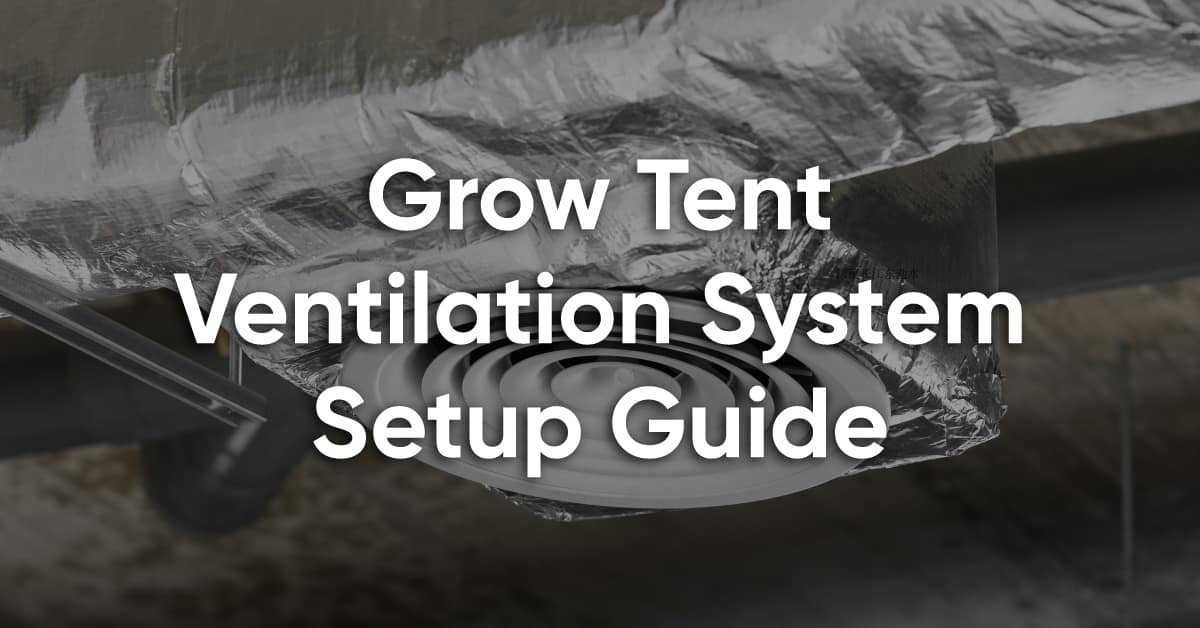Humidity Control: How to Lower or Raise Humidity in Your Grow Tent?
Since you are here, you probably know that grow tents have become the #1 choice for home growers! Grow tent setups allow growers to create a controlled environment where plants can thrive year-round. One of the most crucial factors for maintaining an ideal environment is humidity control.
Proper humidity levels directly influence plant health and growth rate, making it essential to understand how to control the relative humidity (RH) in grow tents. From the times of popping seeds to full-force flowering plants, controlling humidity becomes even more important as the plant matures!
What's the Best Humidity for Grow Tents?
The humidity level differs in various marijuana growth stages. Below, you will find each stage and its recommended humidity range (RH%) in your grow tents, as well as any possible issues the plant may encounter if the humidity drops or rises to dangerous levels.
Seedlings

Marijuana seedlings are very delicate and have very little root development to uptake water, so they rely on high humidity to absorb moisture from the air through their leaves. For this reason, seedlings thrive in 65%-70% humidity.
- If humidity drops too low: Seedling roots can dry out, which can cause death.
- If there's too much humidity: Mold may grow on the first sprout, potentially infecting the plant.
Clones
Unrooted clones and newly rooted clones have very little to no root developmentbut need to support more plant mass than seedlings. For this reason, UNROOTED clones need as much humidity as they can get. This is why humid domes can be used, which keeps humidity levels between 75%-90%.
Once the clones have visible roots growing out of the rooting plug, you can then start reducing the humidity levels in the dome. Gradually open the vents in the dome daily to harden off the clone, and get the clone used to the vegetative environment it will soon be moved into.
- If humidity drops too low: Unrooted clones won't be able to root and will die. Rooted clones may wilt, as the root zone may dry out and die.
- If there's too much humidity: Mold or mildew may grow on the clone/roots/medium, the stem may rot and the clone will die. High humidity also increases the risk of cannabis pest infestations.
Veg Stage

During the cannabis veg stage, the plant in grow tents benefits from a humidity level between 50-65%. This range helps the plants balance moisture retention and transpiration, which supports vigorous growth.
- If humidity drops too low: The plant can adjust to low levels of humidity by increasing water uptake. However, if humidity stays extremely low (below 40%) or is consistently low for a long time, the plant may start to droop, leaves will wilt; if not corrected in a timely manner, it can even kill the plants.
- If there's too much humidity: High humidity increases the risk of mold, mildew, and pest infestation. Since the cannabis plant may get overwatered, roots may start to die, slowing down or stalling out the plant growth completely.
Short on time to manage your plants? Check out the Hey abby GrowMate! It automatically adjusts lighting, airflow, temperature, and humidity inside your indoor grow tent, so you don’t have to. Spend just 15 minutes a week and in 3 months, you’ll be harvesting pounds of top-quality dried flowers.
Flowering Stage

While the marijuana plant is flowering, it goes through several phases, each having different humidity requirements!
In the early flowering stage ("The Stretch"), the plant grows vigorously in height. So providing humidity levels that contradict this growth spurt can help keep the plant shorter. For this reason, it's best to keep the RH on the lower side of around 40%-50%.
During mid flowering (weeks 4-7), the plants shift focus from growing in size to flower production. Providing a humidity level that facilitates the flower growth can be beneficial to the yield potential. We recommend growers keep the humidity between 50%-60% in this phase.
For the late and final weeks of flowering, you really want to cool down and dry the grow tent out as much as you can. Providing a cool, dry environment helps the flowers tighten up and build that solid, dense structure everyone looks for in quality buds! Running a drier environment is also crucial for avoiding mold and mildew in the late weeks of flowering. As the plant nears senessence, its immune response is almost nonexistent and it has the largest amount of plant tissue (buds) to support. This is a recipe for bud rot if the humidity is too high. By keeping the humidity below 50%, and ideally closer to 40%, you can reduce the risk of mold and mildew, ensuring firmer, denser buds at harvest.
- If humidity drops too low: The plant can adjust by increasing water uptake. However, if it falls to extremely low levels (< 40%), it can place unnecessary stress on the plant. This may lead to slowed growth, damaged leaves, drooping or wilting, and an overly dry medium that harms the root zone.
- If there's too much humidity: Growth and bud development will slow down tremendously. The buds will be very fluffy and airy, lacking quality. In the later weeks, bud rot may start to grow towards the center of the buds if humidity is not managed properly.
Drying Stage
Humidity is probably the MOST important during the cannabis drying process. If humidity isn't managed properly, the 13+ weeks spent on growing your cannabis plants could be ruined! Temperature and humidity work together to make sure your plants dry evenly while preserving as many favorable compounds as possible.
Ideally, for the first 2 days, you want to keep the temp ~72°F and the humidity ~55% RH (1.2kPa).
After the initial 2 days, you want to give the plants an adjustment period to allow the moisture to even out in the plant tissue, so the buds don't dry on the outside only. You will want to adjust the conditions to ~74°F and ~52% RH (1.39kPa) for the next 24 hours.
Next on, you want to remove the final bit of moisture from the buds. Aim for ~75°F and VPD of 1.5 kPA. After a total of 5 days under these controlled conditions, your plants should be ready for trimming and jarring!
- If humidity drops too low: The buds will release moisture too fast, leading to over-drying.
- If there's too much humidity: The buds won't dry quickly enough, resulting in mold and mildew infection.
How to Lower Humidity in Grow Tent?
There are different ways to go about lowering humidity levels in your grow tent:
1. Ventilation

Having a proper grow tent ventilation setup is the easiest, most cost-effective, and quickest way to lower and control humidity! Most systems even use a controller that allows for automation, which makes it easier to create an ideal environment.
2. Air Movement
Ensuring adequate air movement between and around the plant will help avoid big spikes and pockets of humidity around the tent! Fan placement should also be a consideration; positioning fans to blow air up through the canopy can help reduce the humidity level at the canopy level.
3. Dehumidifying
The most effective way to reduce humidity in grow tents, which may also be the most costly, is using a dehumidifier! Grow tent dehumidifiers directly remove moisture from the air, working great in more crowded or larger grow tents where simple ventilation can't get the job done.
To make sure you get the right dehumidifier, consider the following factors:
- tent size
- plant count
- lighting
- style of growing
Here's a formula to calculate your dehumidification needs:
Moisture Load (pints a day) X Number of Plants = Total Pints Per Day Needed to be Removed
- Moisture Load: number of plants X water usage per plant
- Water Usage: Cannabis plants typically transpire between 0.3 to 1 gallon of water a day. Plants in cooler or LED grow spaces will be on the lower side of that range. LED grow spaces also retain more humidity, so it's a good idea to add 10% as a buffer zone (to be safe).
Make sure the dehumidifier of choice can cover the square footage of your grow tent.
4. Air Conditioning
Air conditioners help remove moisture from the air as well! By reducing the temperature, they effectively decrease RH%. A/C units use evaporator coils that condense the air passes through, causing moisture to form as condensation. The A/C collects this condensation and drains it away.
5. Watering Practices

Overwatering or watering too frequently is a major cause of humidity issues in grow tents. It will cause excessive water remaining in the grow medium and runoff system, which will passively increase humidity.
6. Standing Water
Speaking of runoff system, make sure you regularly empty runoff catchment trays, drawers, saucers or buckets, so there is no standing water in the grow tent. Standing water will evaporate and passively increase the humidity and attract pests and diseases.
7. Defloating
One final effort to lower humidity in grow tent is to defoliate your cannabis plants. Removing some foliage will help increase air flow and ventilation while slightly reducing the plant's transpiration rates. Make sure to defoliate strategically to avoid harming your plants. This should be one of your last efforts to manage humidity effectively.
8. Plant Count
The last straw is taking some plants out. If you have too many plants, or your grow tent is overcrowded, humidity will be extremely hard to control.
How to Raise Humidity in Grow Tent?
Now that you know how to lower humidity in grow tents, you might be wondering how to humidify the grow tent, cheaply. With a few affordable and reliable grow tent accessories, you can easily boost the humidity levels:
1. Use a Humidifier
The easiest and most efficient way to increase humidity is adding a humidification device for plants. They're designed to release water vapor into the environment to increase the humidity level to desired conditions.
You can also try to add a wet towel, tray of water, or bowl of ice to the grow tent; as these items heat up, the water will evaporate and release humidity.
2. Reduce Ventilation
Reducing the ventilation duration or frequency of ventilation cycles can help humidity build in the grow tent. The consistent airflow from fresh air coming in can sometimes dehydrate the medium and leaves, and doesn't allow for the vapor to be properly absorbed by the plants.
3. Lower Temperature
The inverse relationship between humidity and temperature allows humidity to increase if you reduce the temperature. Cooling down the tent sometimes will help raise humidity in the grow tent.
Best Way to Control & Monitor the Grow Tent Humidity
The best way to both monitor and control humidity in your grow tent is pretty cut and dry! Use a well-built ventilation system equipped with the proper tools!
All growing spaces are different. What works for Joe's tent may work for Joan's tent, but not work for yours. You need to figure out what your specific space requires and use the right equipment to manage the specific conditions.
This is why I always recommend running a test in your grow tent before bringing in plants. Using an exhaust fan ventilation system or an air conditioner can significantly help in controlling humidity levels. In my experience, if you can use one of those two units with a controller that allows you to automate the equipment, you'll be set!
Get Weekly Expert Tips, and Grow Healthy Plants
Join our newsletter to get exclusive growing tips delivered directly to your inbox.




